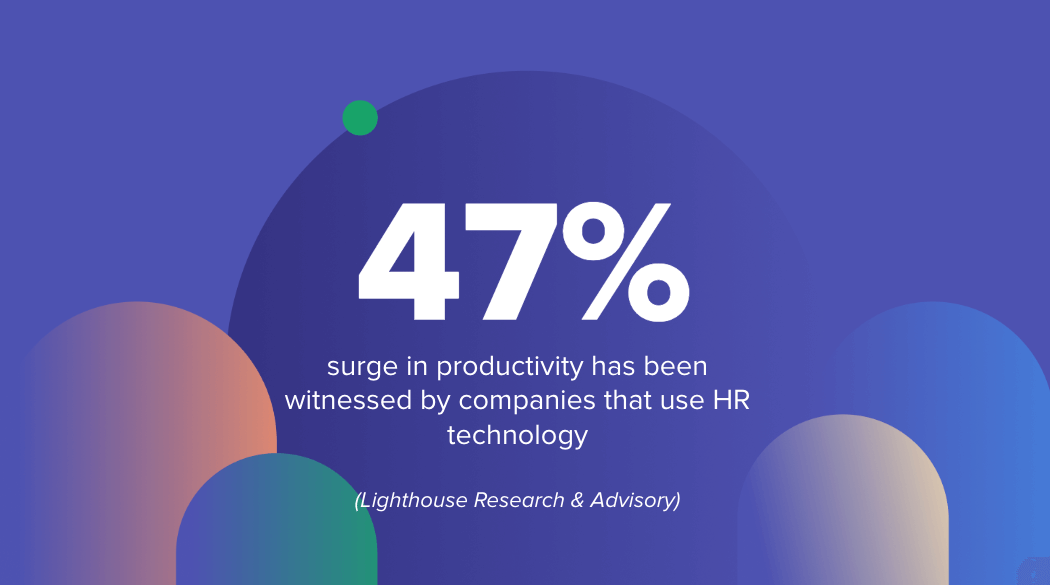The ROI of HR technology integration explained
Understanding the ROI of HR technology is more than a matter of financial calculus, it's about appreciating its impact on the modern workplace. From automating administrative tasks to providing strategic insights through data analytics, HR technology is becoming integral to every organization.

The strategic advantages of HR technology extend beyond operational efficiencies and financial metrics. The ROI of HR technology integration is more than that. It touches the very core of organizational culture, transforming it into a more agile, informed, and engaged entity.
This shift is not merely about keeping pace with technological advancements but about reimagining the role of HR in driving business success.
Contents
The benefits of HR technology
Notably, companies that use HR technology like an ATS or an HRIS have witnessed, according to Lighthouse Research & Advisory report, a 47% surge in productivity—an impressive figure that underscores the efficiency gains enabled by modern HR solutions.

This leap in productivity is more than a mere enhancement of work processes; it represents a transformation in how tasks are executed, making room for strategic endeavors that propel the organization forward.
Beyond productivity, the integration of HR technology has been instrumental in improving the accuracy and insightfulness of reporting.
With a 73% improvement in reporting capabilities, businesses are now better equipped to make data-driven decisions that align with their strategic goals.
This leap in data accuracy and insights is a game-changer, offering a clear view of the workforce dynamics and enabling a proactive approach to talent management.
Perhaps one of the most compelling outcomes of HR technology adoption is its impact on employee engagement. Companies with recent HR technology implementations are twice as likely to observe enhanced engagement among their workforce.
This heightened level of engagement is a testament to the technology’s role in creating a more connected, transparent, and responsive work environment.
Trends shaping HR technology investments in 2024
As we venture into 2024, the landscape of HR technology investments is shaped by a series of emerging trends that reflect the evolving priorities of businesses and HR leaders alike.
One of the most authoritative voices in the realm of HR technology, Josh Bersin, highlights the growing significance of Talent Marketplace platforms, Capability Academies, Employee Experience Platforms, and mid-market talent suites in his latest HR Technology Report.
These categories represent a shift towards more personalized, agile, and comprehensive HR solutions that cater to the diverse needs of the modern workforce.
The emphasis on Employee Experience Platforms is particularly noteworthy. In an age where the employee experience is as crucial as the customer experience, these platforms offer a holistic approach to engaging, developing, and retaining talent.
By integrating various aspects of the employee lifecycle, from onboarding to development and performance management, these platforms are setting new standards for what it means to be a ‘great place to work.’
Backing this trend is a survey by Gartner, which reveals a notable shift in budget priorities among HR leaders. According to the survey, 89% of HR leaders plan to increase their HR technology budget this year, double the number from last year’s report, signaling a strong commitment to leveraging technology for strategic advantage.

The convergence of these trends points to a broader realization among businesses: investing in HR technology is not just a tactical move but a strategic imperative.
The ROI of HR technology integration: Applicant Tracking Systems (ATS)
The ROI of an ATS extends beyond mere cost savings, embedding itself in the strategic fabric of the recruitment process.
Let’s see the most important factors that can benefit your organization using an ATS.
1. Avoiding bad hires
One of the primary benefits of an ATS is its ability to improve the quality of hires.
By automating the screening process and leveraging sophisticated algorithms to match candidate profiles with job requirements, ATS significantly reduces the risk of bad hires—a scenario that can cost organizations dearly, both financially and culturally.
A study by ResearchGate underscores the efficiency of technology in recruitment, showing that an ATS can enhance the selection process, ensuring a better fit between the candidate and the organizational needs.
2. Reducing external recruitment costs:
External recruitment efforts, including agency fees and advertising costs, can accumulate rapidly. An ATS streamlines the recruitment process, making it more efficient and less reliant on external resources.
By building a robust talent pool and enhancing the employer brand through a seamless candidate experience, organizations can reduce external recruitment costs significantly.
3. Boosting recruiter productivity
The automation of routine tasks, such as resume screening and scheduling interviews, frees up recruiters to focus on more strategic aspects of their role, such as engaging with candidates and enhancing the recruitment strategy.
This shift towards strategic tasks is not only more fulfilling for recruiters but also adds greater value to the organization, as highlighted in the efficiency improvements reported by companies implementing recent HR technology.
4. Decreased time to fill
The speed at which vacancies are filled is critical in maintaining organizational productivity. An efficient ATS reduces the time to fill by streamlining the entire recruitment process, from posting job ads to making the final offer.
This efficiency not only impacts the bottom line by minimizing the costs associated with vacancies but also enhances the organization’s agility in responding to market demands.
The ROI of HR technology integration: Human Resource Information Systems (HRIS)
Human Resource Information Systems (HRIS) serve as the backbone of HR operations, integrating various HR functions into a unified system. The ROI of an HRIS is manifested through direct cost savings, improved efficiency, and strategic contributions to the organization.
Let’s explore the factors that can save you time and money:
1. Time savings value
The core value of an HRIS lies in its ability to save time for HR professionals and employees alike.
By automating administrative tasks, such as leave requests and benefits administration, an HRIS frees up time that can be redirected towards strategic HR initiatives.
2. Total system costs vs. savings
Evaluating the ROI of an HRIS involves a careful analysis of the total costs—implementation, training, and maintenance—against the tangible savings it delivers.
Cloud-based HRIS solutions like Workable, for example, offer lower upfront costs and scalability, presenting a compelling case for their higher ROI as reported by HR Executive, which highlights the cost-effectiveness of cloud technology in HR operations.
3. Adoption rate and employee feedback
The success of an HRIS is also measured by its adoption rate and the feedback from its users.
A high adoption rate indicates that the system is user-friendly and meets the needs of its users, contributing to its overall ROI.
Employee feedback, including eNPS scores, offers insights into how the HRIS affects employee satisfaction and engagement, further influencing the system’s value to the organization.
4. Engagement scores and productivity
Finally, the impact of an HRIS on employee engagement and overall productivity cannot be overlooked.
By facilitating a better employee experience and streamlining HR processes, an HRIS can lead to higher engagement scores.
This enhanced engagement is directly linked to increased productivity, as engaged employees are more motivated and committed to their work, driving the organization’s success.
These sections delve into the tangible and intangible benefits of ATS and HRIS, providing a detailed look at how these systems contribute to the ROI of HR technology integration.
By examining specific metrics and impacts, the narrative underscores the strategic value of investing in HR technology to optimize recruitment processes and HR operations.
Best practices for maximizing HR Technology ROI
The decision to invest in HR technology is a significant one, carrying the promise of enhanced efficiency, better employee experiences, and, ultimately, a stronger bottom line.
However, the realization of these benefits is contingent upon strategic implementation and continuous optimization.
Herein lies the blueprint for maximizing the ROI of HR technology:
Strategic implementation and alignment: The foundation of a successful HR technology integration is its alignment with the organization’s broader business goals and HR strategy.
This alignment ensures that the selected technology solutions directly contribute to achieving strategic objectives, be it through improving recruitment processes, enhancing employee engagement, or streamlining administrative tasks.
Organizations should undertake a needs analysis, involving key stakeholders in the process, to identify the most pressing requirements and the best tech solutions to address them.
Continuous training and support: To achieve a high adoption rate and ensure that all users can leverage the HR technology to its full potential, continuous training and support are paramount.
This involves not only initial training sessions but also ongoing support and refresher courses to accommodate updates in the technology and changes in organizational processes.
Such an approach encourages user engagement with the technology, ensuring that it becomes an integral part of the HR workflow.
Data-driven decision making: One of the most significant advantages of modern HR technology is its ability to generate actionable insights through data analytics.
Organizations should capitalize on this by regularly reviewing analytics and reports generated by their HR systems.
This data can inform strategic decisions, from identifying areas for process improvement to uncovering trends in employee engagement and productivity. Moreover, it serves as a direct feedback loop for assessing the technology’s impact and ROI.
Feedback mechanisms and continuous improvement: The landscape of HR technology is ever-evolving, with new solutions and updates emerging at a rapid pace.
To maintain an optimal ROI, organizations must embrace a culture of continuous improvement.
This involves not only staying abreast of technological advancements but also soliciting and acting on feedback from users.
Regular surveys and feedback sessions can reveal insights into the system’s effectiveness, usability, and areas for enhancement, guiding future investments and technology optimization efforts.
In the digital age, the question is no longer whether to invest in HR technology but how to maximize its value for the organization.
With a strategic approach to HR technology integration and an eye on the evolving landscape, businesses can navigate the complexities of the modern workforce, ensuring their position at the forefront of innovation and success.
Frequently asked questions
- How does HR technology enhance organizational productivity?
- HR technology, such as ATS and HRIS, increases productivity by 47% by streamlining task execution, freeing up time for strategic initiatives. This transformation leads to more efficient work processes and allows for a focus on growth-driving activities.
- What impact does HR technology have on reporting and decision-making?
- With a 73% improvement in reporting capabilities, HR technology offers unparalleled data accuracy and insight, empowering businesses to make informed, strategic decisions. This leap in reporting efficiency provides a comprehensive view of workforce dynamics, fostering a proactive approach to talent management.
- Can HR technology improve employee engagement?
- Yes, companies implementing HR technology witness a doubling in employee engagement levels. This technology fosters a more connected, transparent, and responsive work environment, significantly enhancing the overall employee experience and satisfaction.
- What trends are shaping HR technology investments in 2024?
- In 2024, investments are driven by the need for Talent Marketplace platforms, Capability Academies, Employee Experience Platforms, and mid-market talent suites. These trends indicate a shift towards personalized, agile HR solutions that enhance the employee experience and support strategic business goals.
- What is the ROI of using an ATS in recruitment?
- The ROI of an ATS includes better quality hires, reduced external recruitment costs, increased recruiter productivity, and decreased time to fill positions. These factors contribute to financial and cultural benefits for organizations, streamlining the recruitment process and aligning with strategic objectives.




